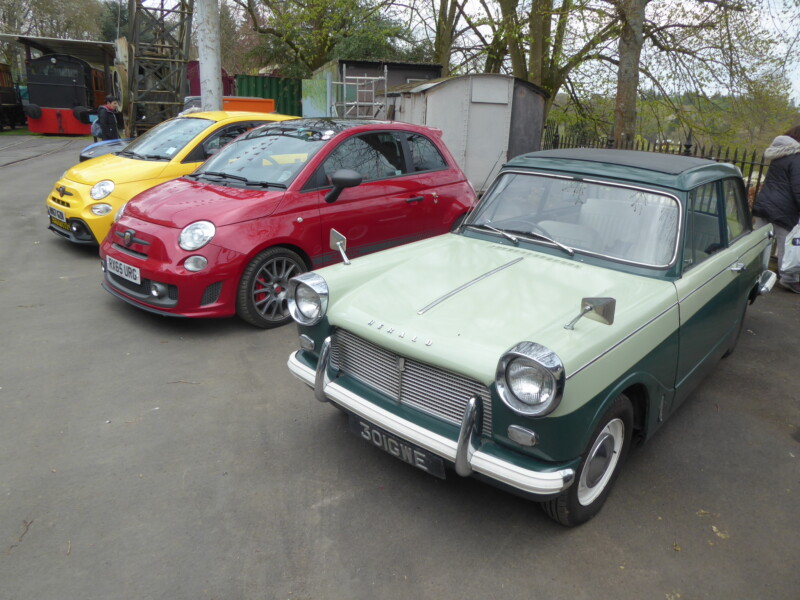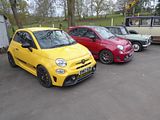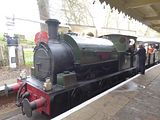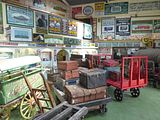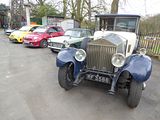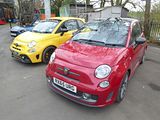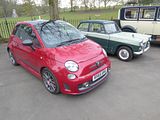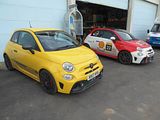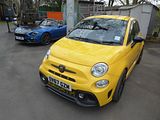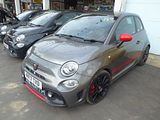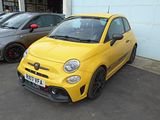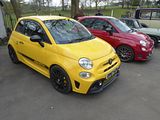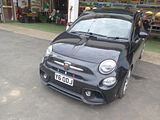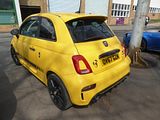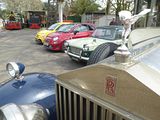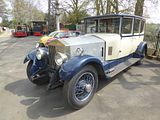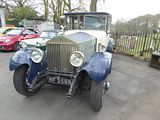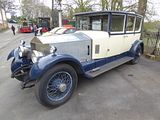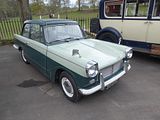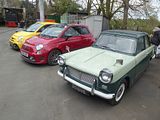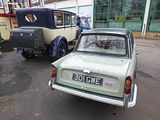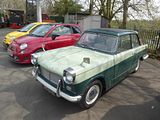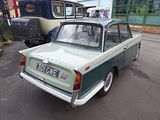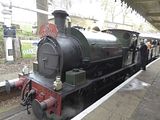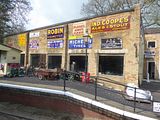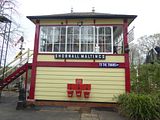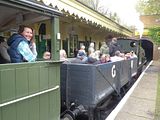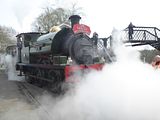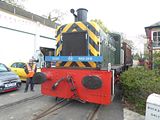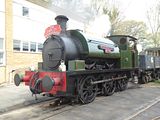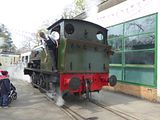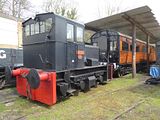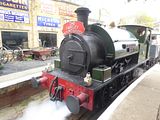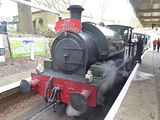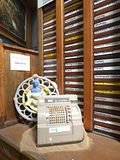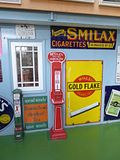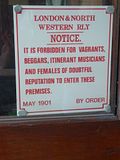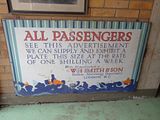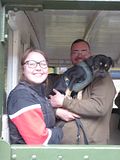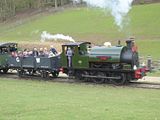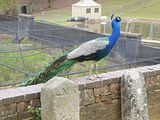There are vast numbers of places of interest in the UK, and it would be quite impossible to visit them all in a life time. Some, of course, are well known and deservedly popular, but there are plenty that, for a variety of reasons, are known only to a handful. The location for this latest Abarth meet, organised through Abarth Berkshire definitely comes in that category. I’d definitely never heard of Fawley Hill and did not know that there was a preserved railway there. When I looked into the details of the event, it quickly became apparent why that might be. For a start, you’d be pretty unlikely to find it by accident. Although it is only a few miles from Marlow, it lies in a valley that is accessed via various other valleys down narrow country lanes that are mostly no more than a car’s width. It’s certainly not the sort of location where you would expect to find any form of railway. Moreover, this is not a venue which is open to the public on a continuous basis. It is privately owned by the MacAlpine family, and to visit, you need to apply and then there is space on one of around 7 or 8 open days a year you may get an invitation. Abarth Berkshire gained access as one of the Group’s founding members, Ben Husband, a keen railway enthusiast as well as a lover of cars, volunteers there and so was able to get the Club on to the list for a visit. Needless to say, I signed up, and persisted with the sat nav directions, despite rather wondering if they could possibly be right, and did make it to the site.
There is a decent sized car park up the hill from the main site, which is here coaches park up (and I am really glad I did not meet a coach en route there or leaving as the roads really are not suitable for them!), but we had been given special permission to park right in the middle of the site. We only had a small number of Abarths there, to join a couple of other interesting cars, so they did generate a lot of interest from everyone who was there.
Rumours started to circulate towards the end of 2014 that Abarth were going to upgrade the Competizione model, so as better to bridge the gap between the Turismo and the 190 bhp 695 Biposto that had been added to the range earlier in the year. It was Geneva 2015 when the result was finally shown to an expectant fan base. Most exciting news was that thanks to a bigger Garrett Turbo, the engine had been tweaked to 180 bhp, and with reduced CO2 emissions. A standard spec that included Koni Dampers, Brembo brakes, Xenon lights, Sabelt seats, Climate Control, parking sensors as well as other refinements that had been added like the TFT instrument display all proved very compelling, so not long after the first cars reached the UK in June of 2015, I found temptation too hard to resist, and as is well documented here, swapped my 2010 car for one of these. At the time I ordered it, Cordolo Red, a tri-coat pearlescent paint which shimmers in bright sunlight looked set to become one of the most popular colours of the lot, even though it is a cost option. Indeed, the Launch Edition models were all offered either in this colour or Scorpion Black, with black wheels. Surprisingly, the colour was not carried over to the Series 4 cars.
Most of the Abarth models here were what is known as the Series 4 version of the familiar 595, which reached the markets in the middle of 2016. After rumours had circulated all winter following the launch of the facelifted Fiat 500 last year, Abarth finally unveiled the Series 4 at the end of May 2016. Initially, we were told that the cars would not be available in the UK until September, but that came forward somewhat, with dealers all receiving demo cars in June, and the first customers taking delivery in July. Three regular production versions of both the closed car and the open-topped C were initially available, all badged 595, and called Custom, Turismo and Competizione, as before, though numerous limited edition models have since appeared and in most case disappeared. The most significant changes with the Series 4 are visual, with a couple of new colours, including the much asked for Modena Yellow and a different red, called Abarth Red, which replaces both the non-metallic Officina and – slightly surprisingly – the tri-coat pearlescent Cordolo Red. as well as styling changes front and rear. The jury is still out on these, with many, me included, remaining to be convinced. At the front, the new air intake does apparently allow around 15 – 20 % more air in and out, which will be welcome, as these cars do generate quite a lot of heat under the bonnet. Competizione models for the UK retain the old style headlights, as they have Xenon lights as standard, whereas the Custom and Turismo cars have reshaped units. At the back, there are new light clusters and a new rear bumper and diffuser. Inside, the most notable change is the replacement of the Blue & Me system with a more modern uConnect Audio set up, which brings a new colour screen to the dash. Mechanically, there is an additional 5 bhp on the Custom (now 145) and Turismo (now 165 bhp) and the option of a Limited Slip Diff for the Competizione, which is likely to prove a popular option. Details of the interior trim have changed, with a filled-in glovebox like the US market cars have always had, and electric windows switches that are like the US ones, as well as a part Alcantara trim to the steering wheel in Competizione cars. These cars have now been on offer for seven years and with Abarth sales on the rise, it was no surprise that they were particularly well represented here.
Final Abarth here was Jeremy Ingham’s 124 Spider. The Abarth 124 Spider was developed in parallel with the Fiat model. It does cost a lot more, and there are those who think you don’t get enough extra for your money, but those who have driven it will tell you otherwise. You certainly get more power. The 1.4 MultiAir turbo unit jumps up from 138bhp to 168bhp, while torque also increases by a modest 10Nm to 250Nm, which gives it a 0-62mph time of 6.8 seconds, which is half a second quicker than the 2.0-litre Mazda MX-5. The top speed is 143mph. It weighs just 1060kg meaning a power-to-weight ratio of 158bhp-per-tonne, and with the new Record Monza exhaust system it sounds great even at idle. The Abarth version gets a stiffer suspension setup than the regular Fiat 124 Spider, with Bilstein dampers and beefed-up anti-roll bars. Bigger Brembo brakes also feature, with aluminium calipers. It can be had with a six-speed manual or six-speed automatic transmission with paddles, and the latter gets a Sport mode for quicker shifts. Many of the UK cars sport the ‘Heritage Look’ pack, which is a no-cost option. It brings a matt black bonnet and bootlid, plus red exterior trim detailing and has proved popular. The £29,565 starting price gets you standard equipment such as cruise control, climate control, Bluetooth, a DAB radio and satnav, plus Alcantara black and red (or pure black) seat trim. The automatic gearbox is a £2,035 extra, while an optional visibility pack brings LED DRLs, auto lights and wipers and rear parking sensors. Sales ceased during 2019, with around 1800 cars having been brought into the UK, so this is always going to be a rare car, and values are already increasing at a rate reflecting its desirability and the difficulty in finding one.
1927 Rolls Royce Phantom I Thrupp & Maberly: Rolls-Royce’s ‘single model’ policy had proved to be an outstanding success for the company, but immediately after the end of the Great War the recession in the motor trade prompted the introduction of a smaller, cheaper 20hp car to be built alongside the existing 40/50hp Silver Ghost. Henry Royce’s new design incorporated a number of modern features such as overhead valvegear for its six-cylinder engine, a centre-change gearbox, and ‘Hotchkiss drive’ rear axle, and the advanced newcomer’s arrival only served to emphasise the Silver Ghost’s Edwardian origins. However, the 45/50hp model would soon benefit from developments pioneered on its smaller sibling. Introduced in 1925, the New Phantom (retrospectively known as the Phantom I) boasted an entirely new overhead-valve six-cylinder engine displacing 7,668cc, and like the 20hp adopted a disc-type clutch and adjustable radiator shutters. Its chassis though, remained essentially the same as that of the later four-wheel-braked ‘Ghost, and would continue fundamentally unchanged until the arrival of the Phantom II in 1929 brought with it an entirely new frame. Despatched to London-based coachbuilder Thrupp & Maberly in April 1927, New Phantom long-wheelbase chassis number ’91EF’ was sold via Rootes Ltd of Piccadilly to first owner Colonel M A Swinfen-Brown of Lichfield, who service records indicate owned the car until at least 1938. Restored around 1970, the vehicle came into present ownership in 1977 and has been maintained since then by recognised marque specialists as recorded by numerous accompanying invoices. Finished in cream/blue with leather/cloth upholstery,
Triumph Herald 12/50: Towards the end of the 1950s Standard-Triumph offered a range of two-seater Triumph sports cars alongside its Standard saloons, the Standard 8 and 10, powered by a small (803 cc or 948 cc) 4-cylinder engine, which by the late 1950s were due for an update. Standard-Triumph therefore started work on the Herald. The choice of the Herald name suggests that the car was originally intended to be marketed as a Standard, as it fits the model-naming scheme of the time (Ensign, Pennant and Standard itself). But by 1959 it was felt that the Triumph name had more brand equity, and the Standard name was phased out in Britain after 1963. Giovanni Michelotti was commissioned to style the car by the Standard-Triumph board, encouraged by chief engineer Harry Webster, and quickly produced designs for a two-door saloon with a large glass area that gave 93 per cent all-round visibility in the saloon variant and the “razor-edge” looks to which many makers were turning. As Fisher & Ludlow, Standard-Triumph’s body suppliers became part of an uncooperative BMC, it was decided that the car should have a separate chassis rather than adopting the newer monocoque construction. The main body tub was bolted to the chassis and the whole front end hinged forward to allow access to the engine. Every panel – including the sills and roof – could be unbolted from the car so that different body styles could be easily built on the same chassis. As an addition to the original coupé and saloon models, a convertible was introduced in 1960. The Standard Pennant’s 4-cylinder 948 cc OHV engine and 4 speed manual gearbox was used with synchromesh on the top three gears and remote gear shift and driving the rear wheels. Most of the engine parts were previously used in the Standard 8/10. The rack and pinion steering afforded the Herald a tight 25-foot turning circle. Coil and double-wishbone front suspension was fitted, while the rear suspension, a new departure for Triumph, offered “limited” independent springing via a single transverse leaf-spring bolted to the top of the final drive unit and swing axles. Instruments were confined to a single large speedometer with fuel gauge in the saloon (a temperature gauge was available as an option) on a dashboard of grey pressed fibreboard. The coupé dashboard was equipped with speedometer, fuel and temperature gauges, together with a lockable glovebox. The car had loop-pile carpeting and heater as standard. A number of extras were available including twin SU carburettors, leather seats, a wood-vaneered dashboard, Telaflo shock absorbers and paint options. In late 1958, prototype cars embarked on a test run from Cape Town to Tangiers. An account of the journey was embellished by PR at the time. However only minor changes were deemed necessary between the prototype and production cars. The new car was launched at the Royal Albert Hall in London on 22 April 1959 but was not an immediate sales success, partly owing to its relatively high cost, approaching £700 (including 45 per cent Purchase Tax). In standard single-carburettor form the 34.5 bhp car was no better than average in terms of performance. A saloon tested by The Motor magazine in 1959 was found to have a top speed of 70.9 mph and could accelerate from 0–60 mph in 31.1 seconds. A fuel consumption of 34.5 mpg was recorded. The rear suspension was criticised as yielding poor handling at the extremes of performance though the model was considered easy to drive with its good vision, light steering (smallest turning circle of any production car) and controls, and ease of repair. A Herald S variant was introduced in 1961 with a lower equipment level and less chromium than the Herald, offered in saloon form only. The 948cc Herald Coupe and Convertible models were discontinued in 1961, the 948cc Herald Saloon in 1962 and the Herald S in 1964. Standard-Triumph experienced financial difficulties at the beginning of the 1960s and was taken over by Leyland Motors Ltd in 1961. This released new resources to develop the Herald and the car was re-launched in April 1961 with an 1147 cc engine as the Herald 1200. The new model featured rubber-covered bumpers, a wooden laminate dashboard and improved seating. Quality control was also tightened up. Twin carburettors were no longer fitted to any of the range as standard although they remained an option, the standard being a single down-draught Solex carburettor. Claimed maximum power of the Herald 1200 was 39 bhp, as against the 34.5 bhp claimed for the 948 cc model. One month after the release of the Herald 1200, a 2-door estate was added to the range. Disc brakes became an option from 1962. Sales picked up despite growing competition from the BMC Mini and the Ford Anglia, with the car proving particularly popular to women drivers. The coupé was dropped from the range in late 1964 as it was by then in direct competition with the Triumph Spitfire. The Triumph Courier van, a Herald estate with side panels in place of rear side windows, was produced from 1962 until 1966, but was dropped following poor sales. Production in England ceased in mid-1964. CKD assembly by MCA in Malta continued till late 1965, at least. The Courier was powered by the 1147 cc engine. An upmarket version, the Herald 12/50, was offered from 1963 to 1967. It featured a tuned engine with a claimed output of 51 bhp in place of the previous 39, along with a sliding (Webasto) vinyl-fabric sunroof and front disc brakes as standard. The 12/50, which was offered only as a 2-door saloon, was fitted with a fine-barred aluminium grille. The power output of the 1200, which remained in production alongside the 12/50, was subsequently boosted to 48 bhp. In October 1967 the range was updated with the introduction at the London Motor Show of the Herald 13/60, which was offered in saloon, convertible and estate-bodied versions. The sun-roof remained available for the saloon as an optional extra rather than a standard feature. The front end was restyled using a bonnet similar to the Triumph Vitesse’s and the interior substantially revised though still featuring the wooden dashboard. Interior space was improved by recessing a rear armrest in each side panel. The engine was enlarged to 1296 cc, essentially the unit employed since 1965 in the Triumph 1300, fitted with a Stromberg CD150 carburettor, offering 61 bhp and much improved performance. In this form (though the 1200 saloon was sold alongside it until the end of 1970) the Herald Saloon lasted until December 1970 and the Convertible and Estate until May 1971, by which time, severely outdated in style if not performance, it had already outlived the introduction of the Triumph 1300 Saloon, the car designed to replace it and was still selling reasonably well but, because of its labour-intensive method of construction, selling at a loss.
Having looked at the cars, it was time to enjoy the rest of the site. Fawley Hill is the private estate of the late Sir William McAlpine and Lady McAlpine in the heart of the English countryside. Once described by Country Life magazine as ‘the most bonkers estate in Britain’, it is home to a restored Victorian railway station, the steepest standard gauge railway track in the world, a railway museum and over 20 animal species.
The railway began slowly and No. 31 came in its early days: McAlpine’s very last working engine but even she was to be sold for scrap: so Sir William paid her scrap value and said “Send her home.” The story of her progress across the fields to Fawley Hill made it into the national papers. So, as the terrible race to “modernise” gripped the country and historic buildings were pulled down and replaced with concrete boxes (admittedly many being built by McAlpines!) or worse and stations began to close, with so much being broken up, melted down, thrown away: Sir William kept saying “Send it home”.. and everything that came here was carefully preserved and lovingly placed in the garden or the museum which had started life as a home for his traction engines and the family car collection. Eventually, of course, an entire station building was saved, sliced up, loaded onto lorries and brought here from Somersham to be reassembled and to play its part in the magic that is Fawley. Often parked in the station is “GE 1″ the beautiful wooden private Saloon built for the Chairman of the Great Eastern Railway. Being Canadian, he had it built with a “balcony” on which, presumably, to smoke his cigars as he toured his empire. Two carriages from Royal Trains joined the collection: one Her Majesty’s private carriage and one the nursery coach for Prince Charles and Princess Anne. They are now permanently parked and provide occasional spare bedrooms. To this day the museum and railway are maintained and operated by a wonderful team of volunteers.
There’s some wonderful memorabilia here, with period signs, some of which you just could not use these days!
The location, and the fact that everything has to come in, and leave by road, means that there are no large locomotives here, but there is a variety and the volunteers moved things around during the day, so that we could all see different locos in action There is a short train ride down the hill. In fact this is the steepest non-cog railway gradient in the UK, but the little saddle tank seemed to make light work of it, as it chuffed back up to the main station area.
As many people are aware, Fawley Hill is also an Animal Sanctuary as accidental in its conception as was the railway. Sir William had been involved with ZSL (London & Whipsnade Zoos) for longer than he cared to remember. He discovered very early on that while all the Zoos in the world (but we concentrate on Europe) constantly move animals around in order to prevent inbreeding and to conserve species which are dying out in the wild, there comes a point with most species where there is an imbalance: too many males usually. This is where Fawley came in. Zoos cannot afford to keep “spare” men who just loaf about and need feeding: so they come here, where they live virtually wild. On site here they are fed each day and there are plenty of houses and shelters but none are allocated and no-one makes the animals “go to bed” at night. Among the animals who live here are: cats, dogs, a multitude of hens, ducks and geese, a plethora of goats; we have red, fallow, roe, axis, sika and hog deer, sitatunga, addax, barasinga, wallabies, reas, emus, peacocks, tapirs, capybaras, alpaca, guanaco, llamas, racoons, coatis, meerkats, porcupines, maras, chinchillas, rabbits, tortoises and lemurs. Our old oryx and nilgai have died of extreme old age. I don’t think I have ever seen so many peacocks as there were here – and if you can’t see them, you will certainly here them first, as these are not quiet birds.
All of those who went along really enjoyed this day, which as a bit different from the usual Abarth gathering. It was disappointing that more members did not come along, and of course when they saw the pictures, plenty expressed the view that they wished they had done so. Hopefully they, and I, will get the chance to do so in 2024, as Ben has promised to get us another slot.

